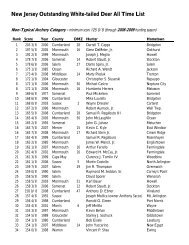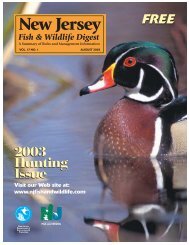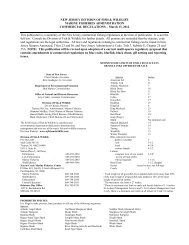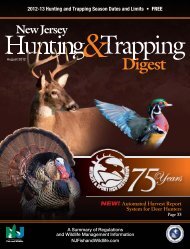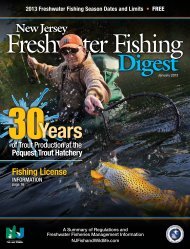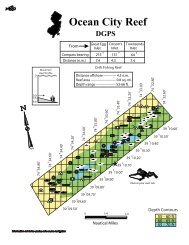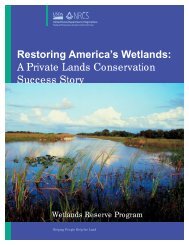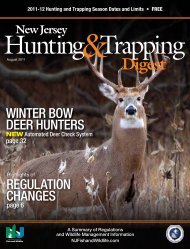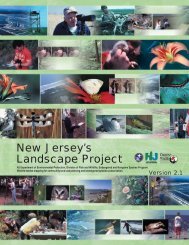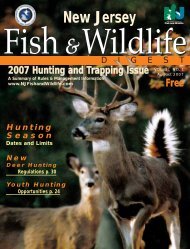Berkshire Valley Wildlife Management Area - State of New Jersey
Berkshire Valley Wildlife Management Area - State of New Jersey
Berkshire Valley Wildlife Management Area - State of New Jersey
Create successful ePaper yourself
Turn your PDF publications into a flip-book with our unique Google optimized e-Paper software.
<strong>Berkshire</strong> <strong>Valley</strong><br />
<strong>Wildlife</strong> <strong>Management</strong> <strong>Area</strong><br />
Forest <strong>Management</strong> Activities | 1991–present<br />
By Miriam Dunne, Northern Region Habitat Biologist (photos by author)<br />
<strong>Wildlife</strong> <strong>Management</strong> <strong>Area</strong>s (WMAs) in<br />
the northern part <strong>of</strong> the state provide<br />
nearly 50,000 acres <strong>of</strong> woodland wildlife<br />
habitat, much <strong>of</strong> it in mid to later stages <strong>of</strong> the<br />
natural regrowth and replacement <strong>of</strong> plant communities<br />
over time known as ecological succession.<br />
Older, uneven-age stand in foreground with<br />
younger, dense stand in background.<br />
Forest stands cut in 1996 are regenerating from<br />
stump sprouts (American chestnut shown above),<br />
from seedlings present in the stand before harvest<br />
and from seeds that have germinated after harvest<br />
(below).<br />
Younger forests have a more open canopy, allowing<br />
more sunlight to enter the forest floor resulting in<br />
a dense growth <strong>of</strong> tree and shrub seedlings, grasses,<br />
forbs and vines. As the forest ages, trees grow and<br />
outcompete other plant species that are intolerant<br />
to shade. For about the first 25 years following a<br />
harvest (cut), the structure <strong>of</strong> a regenerating forest<br />
contains a dense growth <strong>of</strong> trees and shrubs plus<br />
provides food and cover for numerous wildlife<br />
species. As trees grow and compete with each<br />
other for sunlight, many will be eliminated naturally<br />
and the stand will become less dense. Older<br />
growth forests (120 + years) typically contain larger<br />
diameter trees, standing dead trees and decaying<br />
logs, a closed canopy with gaps allowing sunlight<br />
<br />
trees. Early, mid and later successional stages <strong>of</strong><br />
forest growth are each important to wildlife; it is<br />
the goal <strong>of</strong> forest management activities on state<br />
WMAs to have all successional stages represented.<br />
To that end, forest management activities were<br />
<br />
Twp, Morris County) since the early 1990s to<br />
increase the amount <strong>of</strong> early successional forest areas<br />
available for species like ruffed grouse, chestnut-sided<br />
warbler and prairie warbler. A cooperative effort<br />
was undertaken between <strong>New</strong> <strong>Jersey</strong> Division <strong>of</strong><br />
Fish and <strong>Wildlife</strong>, the Ruffed Grouse Society and<br />
<strong>New</strong> <strong>Jersey</strong> Division <strong>of</strong> Parks and Forestry to create<br />
diversified age classes <strong>of</strong> forest stands. Forest<br />
management activities were initiated to “set back”<br />
the plant successional stage in patches <strong>of</strong> the 80 - 110<br />
year old oak-hickory forest, allowing young shrubs<br />
and trees to flourish where the old growth had<br />
been established. Over the course <strong>of</strong> these 20 years,<br />
<br />
harvested in an even-aged system. These areas have<br />
regrown producing a high stem density cover type<br />
that is valued by many species <strong>of</strong> wildlife.<br />
<strong>Berkshire</strong> Background<br />
<br />
2,000 acres, mostly forest. Like all <strong>of</strong> <strong>New</strong> <strong>Jersey</strong>,<br />
<br />
the mid to late 1800s for sawlogs, fuel and charcoal<br />
production. More than half <strong>of</strong> this WMA was<br />
purchased in the 1940s specifically for wildlife<br />
habitat. During the ensuing years there has been<br />
minimal forest management activity.<br />
In the early 1990s, the Division <strong>of</strong> Parks and<br />
Forestry worked with Fish and <strong>Wildlife</strong> to undertake<br />
select even-aged management activities. About<br />
22 acres <strong>of</strong> firewood and timber were harvested in<br />
five blocks during 1991. The Ruffed Grouse Society<br />
then funded the development <strong>of</strong> a management<br />
plan by a consulting forester, which Parks and<br />
Forestry approved and implemented. The plan was<br />
designed to produce a mosaic <strong>of</strong> forest stands in<br />
four harvest blocks over a 20-year period resulting<br />
in a checkerboard pattern <strong>of</strong> various-aged stands.<br />
Over the course <strong>of</strong> 20 years, the plan called for<br />
four harvests <strong>of</strong> about 23 acres, creating a total <strong>of</strong><br />
92 acres <strong>of</strong> early successional habitat.<br />
The harvest blocks ranged in size from 1 to 12<br />
acres. The first harvest occurred in September 1991<br />
and resulted in good regeneration <strong>of</strong> black birch,<br />
ash, tulip poplar, shrubs, forbs and grasses. These<br />
blocks, now 20 years old, have reached the stem<br />
<br />
the end <strong>of</strong> their prime as early successional habitat.<br />
A second round <strong>of</strong> harvesting took place from<br />
1996 through 1997. As with the initial cuts, these<br />
forest blocks ranged from 1.5 to 7 acres. Good regeneration<br />
<strong>of</strong> hardwoods resulted, with both nominal<br />
deer browse and invasive plants (non-native, rapidly<br />
spreading intruders) in the understory.<br />
Habitat <strong>Management</strong> Becomes<br />
More Sophisticated<br />
<br />
in the winter <strong>of</strong> 2008. Care was taken to leave<br />
adequate mast trees (nut bearing) on the periphery<br />
<strong>of</strong> the cuts to enable oaks to seed in. Cut tree tops<br />
left within the harvest blocks provide coarse woody<br />
debris which is beneficial to a number <strong>of</strong> insects<br />
(and animals that eat these insects), and also forms<br />
a temporary barrier to deer which discourages<br />
browsing on tree seedlings. Cavity trees (used for<br />
shelter and nesting) and select mast trees were left<br />
standing in the middle <strong>of</strong> the even-aged blocks.<br />
At the end <strong>of</strong> three growing seasons, the harvest<br />
blocks appear scrubby or brushy. This might be<br />
considered unsightly to some, but these areas<br />
contain a great diversity <strong>of</strong> young trees, shrubs,<br />
brambles, vines, forbs, grasses and sedges. Plant<br />
diversity equates to wildlife diversity.<br />
Harvesting was conducted during the winter to<br />
reduce run-<strong>of</strong>f and minimize the spread <strong>of</strong> invasive<br />
<br />
this precaution, some invasive vegetation is present<br />
80 | <strong>New</strong> <strong>Jersey</strong> Fish & <strong>Wildlife</strong> Digest Buy your license or permit online at August 2011<br />
2011 Hunting and Trapping Issue NJFishand<strong>Wildlife</strong>.com
Japanese stiltgrass can become shaded-out <strong>of</strong> the<br />
developing understory. Other invasives like garlic<br />
mustard and Japanese barberry tolerate shade well<br />
and are much more persistent. In the future, spot<br />
herbiciding prior to harvest will be done when<br />
needed to kill plants like Japanese barberry as<br />
a preventative measure. Winter or late summer<br />
harvesting and better equipment washing prior<br />
to entering the wildlife management area may<br />
reduce the occurrence <strong>of</strong> invasives.<br />
Deer Affect Forest Diversity<br />
Deer management is an important component <strong>of</strong><br />
maintaining or restoring forest health and regeneration.<br />
<strong>Berkshire</strong> <strong>Valley</strong> WMA is located within<br />
Deer <strong>Management</strong> Zone (DMZ) 6, Regulation Set 3,<br />
which allows 120 consecutive days <strong>of</strong> deer hunting<br />
<br />
varies greatly within this zone, from highly populated<br />
suburban areas along the Route 80 corridor on<br />
its southern boundary to the forested uplands along<br />
its northwestern boundary. In 2007, the estimated<br />
deer population density in the huntable portion <strong>of</strong><br />
the herd in Zone 6 was 31 deer per square mile. This<br />
is considerably lower than the estimated densities<br />
in the highly productive agricultural DMZs where<br />
40-plus deer per square mile are thought to be<br />
present. The Zone 6 density is also considerably<br />
more than the single digit density estimates for the<br />
nutrient-poor habitat <strong>of</strong> a Pinelands zone.<br />
Deer can have a huge impact on forest health and<br />
regeneration. In areas with a lot <strong>of</strong> agricultural and<br />
other vegetation able to sustain a large population<br />
<strong>of</strong> deer, high densities will not have a major impact<br />
on the surrounding forest. However, on less-productive<br />
sites, and especially when adjacent suburban<br />
development provides a refuge from hunters, deer<br />
can have a significant impact on forest vegetation.<br />
In 2010, two <strong>of</strong> the harvest blocks at <strong>Berkshire</strong><br />
<br />
<br />
areas to regenerate without influence from deer.<br />
Plant diversity, along with the calculated total<br />
height <strong>of</strong> tree species within and outside <strong>of</strong> the deer<br />
<br />
and used to gauge the long-term impacts from deer.<br />
Regardless <strong>of</strong> the estimated density, the ultimate<br />
test <strong>of</strong> deer density-habitat compatibility in any one<br />
location is the amount <strong>of</strong> plant regeneration present.<br />
At <strong>Berkshire</strong> <strong>Valley</strong>, evidence such as the amount<br />
<strong>of</strong> understory browse observed and the vegetation<br />
<br />
some plant species are preferred by deer (e.g. maple<br />
<br />
density and that hunting pressure is adequate.<br />
Plant Diversity Supports Forest Birds<br />
A breeding bird survey was conducted during June<br />
<strong>of</strong> 2008 and found species including those that prefer<br />
Two deer exclosures were installed to look at deer impacts on regenerating stands.<br />
Regrowth in areas cut in 2008 has resulted in a<br />
dense, diverse assemblage <strong>of</strong> plants.<br />
“interior forest” for nesting (like wood thrush and<br />
scarlet tanager), as well as those that require scrub/<br />
shrub (prairie warbler) and species who need a<br />
well developed understory (worm eating warbler,<br />
black-billed cuckoo). Though many birds that nest<br />
in “interior forest” will not nest in the regenerating<br />
cuts, this habitat is important to them for foraging<br />
after the young fledge and also during migration.<br />
The great abundance <strong>of</strong> berries and insects on the<br />
plants in the cuts makes them a desirable habitat type.<br />
Focus on Grouse<br />
Since one <strong>of</strong> the main goals <strong>of</strong> the forest management<br />
work at <strong>Berkshire</strong> <strong>Valley</strong> was to create grouse<br />
habitat, it is important to monitor the effects on this<br />
species. At one time grouse were fairly common on<br />
<strong>Berkshire</strong>. Grouse surveys conducted during April<br />
and May <strong>of</strong> the last two years have not been fruitful.<br />
It is possible that sufficient source populations do<br />
<br />
<br />
the regenerating habitat. Perhaps there is not yet<br />
enough early successional vegetation in this area.<br />
The home range for a pair <strong>of</strong> grouse is from<br />
50-100 acres, providing there is suitable habitat.<br />
The farther a grouse must travel to meet its living<br />
and breeding requirements, the more likely it is<br />
Opening the canopy to sunlight stimulates the<br />
growth <strong>of</strong> seedlings present before the harvest<br />
(like oak and beech) and releases shade-intolerant<br />
species like birch and ash.<br />
subject to predation. Localized predation from<br />
raptors, cats, raccoons and other predators may be<br />
having an impact on these birds. Disturbance from<br />
illegal ATV and dirt bike activity could also thwart<br />
nesting. It is probably a combination <strong>of</strong> factors.<br />
Successional Success<br />
Activities at <strong>Berkshire</strong> <strong>Valley</strong> <strong>Wildlife</strong> <strong>Management</strong><br />
<br />
management is used successfully as a tool to create<br />
wildlife habitat. Two more rounds <strong>of</strong> timber harvests<br />
are planned under the current management<br />
plan. These cuts are scheduled to take place in 2013<br />
and 2018. By choosing a “no-action” alternative<br />
(no management activity) it will not change the<br />
fact that invasives are likely to be present in the<br />
future stand. The result <strong>of</strong> no action will be little<br />
regeneration <strong>of</strong> trees like oak that need an open<br />
canopy and sunlight reaching the forest floor in<br />
order to thrive. No action will also be detrimental<br />
to a suite <strong>of</strong> species that need the structure and<br />
food supply <strong>of</strong> an early successional forest. Without<br />
oaks in future stands the outlook for wildlife that<br />
depends on oak is bleak. Tolerating some invasives<br />
may be necessary in order to achieve a diversity <strong>of</strong><br />
forest successional stages that is so crucial to forest<br />
health and wildlife diversity.<br />
August 2011 For more information contact <strong>New</strong> <strong>Jersey</strong> <strong>New</strong> <strong>Jersey</strong> Fish & <strong>Wildlife</strong> Digest | 81<br />
Division <strong>of</strong> Fish and <strong>Wildlife</strong> at (609)292-2965<br />
2011 Hunting and Trapping Issue
SELECTING<br />
WATERFOWL<br />
SEASON DATES<br />
An example from the 2010–2011 season<br />
By Ted Nichols, Principal <strong>Wildlife</strong> Biologist<br />
Background<br />
Migratory bird hunting season packages, including<br />
season dates, length and bag limits, are based on<br />
scientific assessments conducted by the U.S. Fish<br />
and <strong>Wildlife</strong> Service and state wildlife agencies<br />
through their respective migratory game bird<br />
flyway councils. Hunting season packages are<br />
developed to reflect a species’ ability to withstand<br />
harvest and yet remain at or above a predetermined<br />
population objective. Migratory bird hunting season<br />
framework dates are annually promulgated by<br />
the U.S. Fish and <strong>Wildlife</strong> Service. <strong>State</strong>s then select<br />
their specific hunting seasons from within this<br />
federal framework. <strong>State</strong>s may be more restrictive<br />
but cannot be more liberal than what is allowed in<br />
the federal framework.<br />
tory<br />
game birds is a balance between scientific and<br />
social factors. Generally, season date selections<br />
are targeted to occur when the birds are most<br />
abundant within a state or zone within a state. In<br />
order to select the best dates, empirical data on<br />
abundance as well as general observations <strong>of</strong> migration<br />
chronology are needed. In addition, managers<br />
must account for social factors including hunter<br />
preferences, traditions and holidays.<br />
In <strong>New</strong> <strong>Jersey</strong>, the process <strong>of</strong> selecting annual<br />
migratory bird hunting season dates begins in<br />
spring when <strong>New</strong> <strong>Jersey</strong> Division <strong>of</strong> Fish and<br />
<strong>Wildlife</strong> (Fish and <strong>Wildlife</strong>) presents recommended<br />
dates to our Fish and Game Council<br />
(Council). Fish and <strong>Wildlife</strong> considers traditional<br />
patterns <strong>of</strong> hunter participation and harvest,<br />
migration chronology and input received from<br />
hunters to arrive at a season selection recommendation.<br />
Council considers Fish and <strong>Wildlife</strong>’s<br />
recommended season dates as well as input from<br />
our constituents before making the final decision<br />
for migratory bird season dates. Proposed season<br />
dates are released by June.<br />
Atlantic Flyway states have had 60-day duck<br />
seasons since 1997. <strong>New</strong> <strong>Jersey</strong> has three zones<br />
(north, south and coastal) where two season segments<br />
are permitted within each zone. Since the<br />
2000–01 season, the Coastal Zone duck season<br />
has generally had a seven to 10 day first segment<br />
in early November with the second segment<br />
opening on Thanksgiving Day and closing in late<br />
January, usually four days prior to the end <strong>of</strong> the<br />
federal duck season framework, which is the last<br />
Sunday in January.<br />
Several years ago, Fish and <strong>Wildlife</strong> and the<br />
Council received requests from waterfowl hunt-<br />
<br />
<br />
November. <strong>New</strong> <strong>Jersey</strong> adopted the suggested format<br />
during 2004–05 (Table 1). Unfortunately, this<br />
season structure resulted in a significant number<br />
<strong>of</strong> complaints from different hunters who voiced<br />
opposition to losing the November days that year.<br />
As a result, the following year Fish and <strong>Wildlife</strong><br />
and our Council reinstated a full week <strong>of</strong> duck<br />
hunting in November in the Coastal Zone. Clearly,<br />
not all waterfowl hunters are in agreement as to<br />
their preferred season date for the Coastal Zone.<br />
Again in 2010 Fish and <strong>Wildlife</strong> received com-<br />
<br />
<br />
early November dates. Since there is contention in<br />
selecting the Coastal Zone season dates, data was<br />
analyzed to compare hunter activity and harvest<br />
success between the first season segment in early<br />
November with the mid-January portions <strong>of</strong> the<br />
Coastal Zone season to make an informed decision<br />
on this issue.<br />
Methods<br />
Hunter harvest and activity data were obtained<br />
from the U.S. Fish and <strong>Wildlife</strong> Service Harvest<br />
Information Program (HIP). HIP data are tabulated<br />
by five-day periods for each year. To determine the<br />
most suitable years for comparison, hunting seasons<br />
<br />
<br />
season into late January. Years were chosen where<br />
there was minimal overlap in duck season dates<br />
in early November between the South Zone and<br />
Coastal Zone since comparisons are confounded<br />
when seasons are open concurrently in more than<br />
one zone. Because <strong>of</strong> considerable annual variation<br />
in harvest and hunter activity data, it is most useful<br />
when the mean harvest and mean hunter activity<br />
<br />
U.S. Fish and <strong>Wildlife</strong> Service<br />
82 |
Table 1. Duck and brant hunting season selections in <strong>New</strong> <strong>Jersey</strong> by zone, 2000-08.<br />
Year<br />
Duck<br />
Season<br />
Length<br />
Brant<br />
Season<br />
Length<br />
Ducks<br />
SZ<br />
Open 1<br />
Ducks<br />
SZ<br />
Close 1<br />
Ducks<br />
SZ<br />
Open 2<br />
Ducks<br />
SZ<br />
Close 2<br />
Ducks<br />
CZ<br />
Open 1<br />
2000 60 50 21-Oct 4-Nov 10-Nov 1-Jan 4-Nov 14-Nov 23-Nov 20-Jan 4-Nov 14-Nov 23-Nov <br />
2001 60 50 20-Oct 1-Dec 14-Dec 3-Nov 13-Nov 22-Nov 3-Nov 13-Nov 22-Nov <br />
2002 60 60 30-Nov 13-Dec 2-Nov 12-Nov 25-Jan 2-Nov 12-Nov 25-Jan<br />
2003 60 60 16-Dec 10-Jan 1-Nov 11-Nov 27-Nov 24-Jan 1-Nov 11-Nov 27-Nov 24-Jan<br />
2004 60 50 16-Oct 27-Nov 14-Dec 11-Nov 13-Nov 25-Nov 11-Nov 13-Nov 25-Nov <br />
2005 60 30 15-Oct 15-Nov 7-Jan 5-Nov 12-Nov 24-Nov 24-Jan 5-Nov 12-Nov 21-Dec 16-Jan<br />
2006 60 30 21-Oct 4-Nov 14-Nov 6-Jan 4-Nov 11-Nov 23-Nov 23-Jan 4-Nov 11-Nov 20-Dec 15-Jan<br />
2007 60 50 20-Oct 3-Nov 13-Nov 5-Jan 3-Nov 10-Nov 22-Nov 22-Jan 3-Nov 10-Nov 22-Nov 10-Jan<br />
60 60 1-Nov 15-Nov 1-Nov 11-Nov 27-Nov 24-Jan 1-Nov 11-Nov 27-Nov 24-Jan<br />
Ducks<br />
CZ<br />
Close 1<br />
Ducks<br />
CZ<br />
Open 2<br />
Ducks<br />
CZ<br />
Close 2<br />
Brant<br />
CZ<br />
Open 1<br />
Brant<br />
CZ<br />
Close 1<br />
Brant<br />
CZ<br />
Open 2<br />
Brant<br />
CZ<br />
Close 2<br />
Results<br />
There were five years (2000 and 2005–08) suitable<br />
for analysis with minimal overlap <strong>of</strong> early<br />
November season dates between the South and<br />
Coastal zones (Table 1, yellow cells). During four <strong>of</strong><br />
<br />
day <strong>of</strong> the first segment <strong>of</strong> the South Zone coincided<br />
with the opening day <strong>of</strong> the first segment <strong>of</strong><br />
the Coastal Zone (Table 1). Although not displayed<br />
in Table 1, the North Zone duck season was closed<br />
<br />
North Zone dates did not confound this analysis.<br />
The first segment <strong>of</strong> the Coastal Zone opened<br />
<br />
have long recognized that hunting activity and<br />
harvest are very high on opening days. As such,<br />
when characterizing early November harvest<br />
and hunting data for the Coastal Zone it is most<br />
reasonable to review data from the Nov. 6-10 period<br />
<br />
Zone harvest, dampening the “opening day effect”<br />
<strong>of</strong> the first several days <strong>of</strong> the Coastal Zone season.<br />
Note that the “opening day effect” would still occur<br />
with a change in season structure where there are<br />
fewer hunting days in early November; hence, the<br />
second five-day hunting period date is utilized.<br />
Data from the periods <strong>of</strong> Jan. 11–15 and Jan.<br />
16–20 were used in the comparison instead <strong>of</strong> the<br />
very last week in January because in some years<br />
the season was not open for the full five days during<br />
that last January week plus the harvest data<br />
proved to be substantially identical for each <strong>of</strong><br />
those weeks. (Table 2.)<br />
Therefore, to analyze hunter activity and harvest<br />
success in the Coastal Zone, the Nov. 6–10<br />
period is compared with Jan. 11–15 and Jan. 16–20.<br />
Quail<br />
Habitat<br />
Case<br />
Study<br />
1975 to 2009<br />
Order this study <strong>of</strong><br />
converting 94 acres <strong>of</strong><br />
Ag land on Maryland’s<br />
Eastern Shore into<br />
a successful multi-species<br />
wildlife habitat area that<br />
produced multiple coveys<br />
<strong>of</strong> wild Bobwhite quail,<br />
woodcock, Delmarva fox<br />
squirrels, wood ducks,<br />
deer, turkey, dove, blue<br />
birds, and wide variety<br />
<strong>of</strong> unique song birds.<br />
Learn how YOU can too!<br />
FREE via email or<br />
$10.00 per hard copy.<br />
All pr<strong>of</strong>its go to the<br />
Ruffed Grouse Society.<br />
Email request or send<br />
check made out to:<br />
Robert Macdonald<br />
309 S. Harrison Street<br />
Easton, MD 21601<br />
www.macfly@goeaston.net<br />
August 2011 For more information contact <strong>New</strong> <strong>Jersey</strong> <strong>New</strong> <strong>Jersey</strong> Fish & <strong>Wildlife</strong> Digest | 83<br />
Division <strong>of</strong> Fish and <strong>Wildlife</strong> at (609)292-2965<br />
2011 Hunting and Trapping Issue
Table 2. Mean annual harvest and hunter activity data by 5-day period in <strong>New</strong> <strong>Jersey</strong> based on HIP data, 2000,<br />
2005-08. (See article for explanation <strong>of</strong> highlighted data.)<br />
Harvest Hunter-days Harvest per hunter-day<br />
Period Total ducks Black ducks Brant Ducks Brant Ducks Brant<br />
Oct. 06–10 1,134 16 0 550 2.06 0.00<br />
Oct. 11–15 20 1,712 1.46 0.51<br />
Oct. 16–20 301 0.21<br />
Oct. 21–25 4,625 343 2,621 6 1.76 1.33<br />
Oct. 26–31 3,141 20 2,141 47 1.47 0.43<br />
Nov. 01–05 3,372 700 2,060 1.64 1.77<br />
Nov. 06–10 1,435 1,221 464 1.21 2.63<br />
Nov. 11–15 2,023 337 313 1.37 <br />
Nov. 16–20 2,744 0 1,741 0.00<br />
Nov. 21–25 1,153 303 3,353 374 <br />
Nov. 26–30 3,117 155 1,635 161 <br />
Dec. 01–05 207 0.72<br />
Dec. 06–10 155 1,670 225 2.14 <br />
Dec. 11–15 3,256 573 166 <br />
Dec. 16–20 233 1.63 0.71<br />
Dec. 21–25 3,334 641 505 1.31 <br />
Dec. 26–31 1,065 3,775 1.27 1.17<br />
Jan. 01–05 1.65 <br />
Jan. 06–10 1,510 332 570 1,445 1.04 1.45<br />
Jan. 11–15 1,665 237 323 1.53 <br />
Jan. 16–20 1,277 153 1,044 1.22 <br />
Jan. 21–25 202 133 1.52<br />
© Debbievdspoel | Dreamstime.com<br />
<br />
<br />
<br />
<br />
<br />
<br />
18-IN-ONE MULTI-TOOL<br />
FOR RIFLES & SHOTGUNS<br />
<br />
<br />
<br />
<br />
® ® <br />
<br />
” <br />
<br />
<br />
<br />
<br />
<br />
<br />
<br />
<br />
<br />
<br />
<br />
<br />
<br />
<br />
888-834-5606<br />
TM<br />
ORDER YOUR<br />
GUN TOOL<br />
ONLINE AND<br />
RECEIVE THE<br />
MAGNETIC BORE<br />
LIGHT<br />
TM<br />
FOR FREE!<br />
(while supplies last)<br />
<br />
<br />
<br />
<br />
<br />
<br />
Sh<br />
www.ShooterTool.com<br />
<br />
84 | <strong>New</strong> <strong>Jersey</strong> Fish & <strong>Wildlife</strong> Digest Buy your license or permit online at August 2011<br />
2011 Hunting and Trapping Issue NJFishand<strong>Wildlife</strong>.com
(See yellow cells in Table<br />
2.) In the Coastal Zone, total<br />
duck harvest and hunting activity<br />
were similar for early November and mid-<br />
January while black duck harvest was considerably<br />
higher during the November period.<br />
Brant seasons are frequently shorter than duck<br />
seasons. When this occurs, brant seasons close<br />
earlier in January than duck season (Table 1, blue<br />
column). As such, the most reasonable comparisons<br />
for brant harvest and hunter activity is between<br />
the Nov. 6–10 and Jan. 6-10 hunting periods (blue<br />
cells, Table 2) because Coastal Zone brant seasons<br />
are usually closed after January 10 (Table 1).<br />
Based on the data in Table 2, brant hunting activity<br />
(blue cells) was only about 15 percent higher in<br />
November than January but brant harvest and<br />
hunter success (measured as harvest/hunter day)<br />
in November are about double that which occurs<br />
in January. In addition, brant harvest and hunter<br />
success were higher during Nov. 6–10 than during<br />
any other<br />
Conclusion<br />
Unless a particular species is well below population<br />
objectives or there are other biological<br />
considerations, selection <strong>of</strong> migratory bird season<br />
dates is largely a social decision. In the <strong>New</strong> <strong>Jersey</strong><br />
Coastal Zone, contemporary duck harvest and<br />
hunting activity is similar when comparing early<br />
November to mid-(and presumably late) January.<br />
However, brant harvest and hunter success during<br />
early November are about double that observed in<br />
January. Clearly, brant hunting is popular during<br />
November and brant hunters are markedly more<br />
successful in early November than they are in<br />
January.<br />
<br />
<br />
more palatable early in the fall when they first<br />
arrive after migration. One potential solution<br />
would be to hold brant seasons during November<br />
independent <strong>of</strong> duck seasons (i.e., the brant season<br />
would be open but the duck season closed) but this<br />
would complicate regulations. However, hunters<br />
have consistently voiced an opinion to hold brant<br />
and duck seasons concurrently whenever possible<br />
in order to simplify regulations.<br />
Based on the analysis <strong>of</strong> hunter behavior and<br />
<br />
<br />
Zone season structure for the 2010–11 hunting<br />
season. Prior to Council arriving at their proposal,<br />
these analyses were shared with sportsmen’s groups<br />
statewide through the <strong>New</strong> <strong>Jersey</strong> Federation <strong>of</strong><br />
Sportsmen’s Clubs. This entire process enabled<br />
resource managers to make data-informed decisions<br />
concerning social issues where two opposing<br />
viewpoints were under consideration. Reporting<br />
on these analyses keeps hunters informed <strong>of</strong><br />
the background data and upfront decisions that<br />
comprise the migratory bird hunting regulation<br />
setting process.<br />
<br />
<br />
<br />
<br />
<br />
<br />
<br />
<br />
<br />
www.DressBigGame.com<br />
phone 888-834-5606<br />
<br />
<br />
<br />
<br />
<br />
THE VISCERA GOES BEYOND A SINGLE<br />
BLADE KNIFE. IT’S A COMPLETE<br />
3-IN-ONE FIELD-DRESSING TOOL.<br />
<br />
<br />
<br />
<br />
<br />
<br />
<br />
<br />
TM<br />
ORDER YOUR<br />
VISCERA<br />
ONLINE AND<br />
RECEIVE THE<br />
MAGNETIC BORE<br />
LIGHT<br />
TM<br />
FOR FREE!<br />
(while supplies last)<br />
<br />
<br />
<br />
<br />
Online bonus<br />
available only at:<br />
www.DressBigGame.com<br />
FREE <strong>of</strong>fer not available with phone orders.<br />
August 2011 For more information contact <strong>New</strong> <strong>Jersey</strong> <strong>New</strong> <strong>Jersey</strong> Fish & <strong>Wildlife</strong> Digest | 85<br />
Division <strong>of</strong> Fish and <strong>Wildlife</strong> at (609)292-2965<br />
2011 Hunting and Trapping Issue
Fall & Winter Trout Stocking<br />
<br />
“ 75 years <strong>of</strong> success,<br />
a partnership for America’s fish and wildlife ”<br />
On September 2, 1937, President Franklin D. Roosevelt signed the Federal Aid<br />
in <strong>Wildlife</strong> Restoration Act (now the Pittman-Robertson <strong>Wildlife</strong> Restoration<br />
Act.) This Act fostered unprecedented partnerships between federal and state<br />
fish and wildlife agencies, the sporting arms industry, conservation groups, and<br />
sportsmen to benefit wildlife —and has been key to implementing the North<br />
American Model <strong>of</strong> <strong>Wildlife</strong> Conservation. In 1950, the Federal Aid in Sport<br />
Fish Restoration Act (now the Dingell-Johnson Sport Fish Restoration Act) was<br />
passed. Together, these programs have contributed more than $10 billion to fish<br />
and wildlife conservation—more than any other single conservation effort in the<br />
United <strong>State</strong>s.<br />
Fall and Winter<br />
Trout Stocking Program<br />
FANTASTIC TROUT FISHING opportunities<br />
await anglers at dozens <strong>of</strong> fall and winter troutstocked<br />
streams and lakes in <strong>New</strong> <strong>Jersey</strong>. These<br />
waters will be stocked with brook, brown and<br />
rainbow trout averaging 14 to 16 inches, and<br />
weighing 3 to 5 pounds.<br />
<br />
large trout during the two-week fall stocking<br />
<br />
large rainbow trout broodstock measuring 18–20<br />
inches. About 5,000 trout are stocked for winter<br />
trout fishing just days before the Thanksgiving<br />
holiday.<br />
Anglers are reminded that all streams and lakes<br />
are open to fishing on the day <strong>of</strong> stocking in the<br />
fall and winter.<br />
All stocking dates are announced on the:<br />
Trout Hotline (609) 633-6765<br />
Fish and <strong>Wildlife</strong>’s Web site at:<br />
NJFishand<strong>Wildlife</strong>.com/trtinfo.htm.<br />
Directions to public access locations for troutstocked<br />
waters are also available on our Web site.<br />
Fall Trout-Stocked Rivers and Lakes<br />
Fall stocking will occur in the weeks beginning<br />
Oct. 10 and Oct. 17, 2011. When available, the<br />
stocking schedule and locations will be posted<br />
on Fish and <strong>Wildlife</strong>’s Web site and the Trout<br />
Stocking Hotline.<br />
Winter Trout-Stocked Lakes<br />
Stocking dates are Nov. 21–23, 2011. When available,<br />
the stocking schedule and locations will be<br />
posted on Fish and <strong>Wildlife</strong>’s Web site and the<br />
Trout Stocking Hotline.<br />
In 2012, we will proudly observe 75 years <strong>of</strong> the WSFR program and the success<br />
<strong>of</strong> the partnerships that have made this program what it is today. We are<br />
planning a yearlong national anniversary program that will be outcome-oriented,<br />
inclusive, and memorable. We hope the anniversary program will act as a catalyst<br />
to make the WSFR program even stronger in the future.<br />
For more information, or to get involved, please contact Christina Zarrella,<br />
USFWS, 703-862-5761 or Christina_zarrella@fws.gov<br />
Continue the Tradition<br />
Become an instructor with Fish and<br />
<strong>Wildlife</strong>’s Hunter Education Program.<br />
Our Hunter Education Unit is looking for <strong>New</strong><br />
<strong>Jersey</strong>’s best sportsmen and sportswomen to<br />
become instructors at locations where students<br />
take the test and field course after first having<br />
completed the home study portion. A minimum<br />
<strong>of</strong> six weekend days each year are required.<br />
Call (856) 629-0552<br />
Leave your name and address to receive an<br />
application. Or visit our Web site:<br />
NJFishand<strong>Wildlife</strong>.com<br />
86 | <strong>New</strong> <strong>Jersey</strong> Fish & <strong>Wildlife</strong> Digest Buy your license or permit online at August 2011<br />
2011 Hunting and Trapping Issue NJFishand<strong>Wildlife</strong>.com
Perpetual Sunrise & Sunset<br />
<br />
Jan. Feb. Mar. Apr. May June July Aug. Sept. Oct. Nov. Dec.<br />
Day Rise Set Rise Set Rise Set Rise Set Rise Set Rise Set Rise Set Rise Set Rise Set Rise Set Rise Set Rise Set<br />
A.M. P.M. A.M. P.M. A.M. P.M. A.M. P.M. A.M. P.M. A.M. P.M. A.M. P.M. A.M. P.M. A.M. P.M. A.M. P.M. A.M. P.M. A.M. P.M.<br />
01 <br />
02 <br />
03 <br />
04 <br />
05 <br />
06 <br />
07 <br />
08 <br />
09 <br />
10 <br />
11 <br />
12 <br />
13 <br />
14 <br />
15 <br />
16 <br />
17 <br />
18 <br />
19 <br />
20 <br />
21 <br />
22 <br />
23 <br />
24 <br />
25 <br />
26 <br />
27 <br />
28 <br />
29 <br />
30 <br />
31 <br />
<br />
Add one hour for daylight savings time when in effect (second Sunday in March and reverts back the first Sunday in November).<br />
Tioga Ranch<br />
Experience is the Difference<br />
www.tiogaboarhunting.com<br />
tiogaboarhunting@yahoo.com<br />
1552 Mann Hill Road, Tioga, PA 16946<br />
August 2011 For more information contact <strong>New</strong> <strong>Jersey</strong> <strong>New</strong> <strong>Jersey</strong> Fish & <strong>Wildlife</strong> Digest | 87<br />
Division <strong>of</strong> Fish and <strong>Wildlife</strong> at (609)292-2965<br />
2011 Hunting and Trapping Issue





